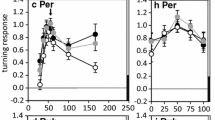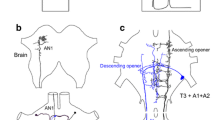Abstract
The acoustic display of many cricket species consists of trains of pulses (chirps) with intermittent pauses. Here, we investigated the temporal cues that females of the cricket Teleogryllus leo used to detect a pulse and a chirp pattern on two different time scales. For both patterns, females accepted a wide range of combinations that covered the respective pulse and chirp parameters in the songs of males. In tests with a continuous series of pulses at different modulation frequencies, the transfer function of pattern discrimination was also determined. Females exhibited two ranges of high response scores indicating two temporal filters with an inhibitory interaction. For the modulation frequency of the pulse pattern, the peak of the preference function was rather sharply tuned and at a lower pulse rate than produced by males. These results show that the combined output of both filters did not increase selectivity, but rather enlarged the accepted range of signals.




Similar content being viewed by others
Abbreviations
- CDC:
-
Chirp duty cycle
- CDUR:
-
Chirp duration
- CPAU:
-
Chirp pause
- CPER:
-
Chirp period
- CV:
-
Coefficient of variation
- PDC:
-
Pulse duty cycle
- PDUR:
-
Pulse duration
- PPAU:
-
Pause duration
- PPER:
-
Pulse period
References
Anderson M (1994) Sexual selection. Princeton University Press, Princeton
Barth FG, Schmitt A (1991) Species recognition and species isolation in wandering spiders (Cupiennius spp.; Ctenidae). Behav Ecol Sociobiol 29:333–339
Beckers OM, Schul J (2009) Developmental plasticity of mating calls enables acoustic communication in diverse environments. Proc R Soc Lond B 275:1243–1248
Bentley DR, Hoy RR (1972) Genetic control of the neuronal network generating cricket (Teleogryllus, Gryllus) song patterns. Anim Behav 20:478–492
Bush SL, Beckers OM, Schul J (2009) A complex mechanism of call recognition in the katydid Neoconocephalus affinis (Orthoptera: Tettigoniidae). J Exp Biol 212:648–655
Deily JA, Schul J (2004) Recognition of calls with exceptionally fast pulse rates: female phonotaxis in the genus Neoconocephalus (Orthoptera: Tettingoiidae). J Exp Biol 207:3523–3529
Deily JA, Schul J (2009) Selective phonotaxis in Neoconocephalus nebrascensis (Orthoptera: Tettigoniidae): call recognition at two temporal scales. J Comp Physiol A 195:31–37
Desutter-Grandcolas L, Robillard T (2003) Phylogeny and the evolution of calling songs in Gryllus (Insecta, Orthoptera, Gryllidae). Zool Scripta 32:173–183
Doherty JA (1985) Trade-off phenomena in calling song recognition and phonotaxis in the cricket, Gryllus bimaculatus (Orthoptera, Gryllidae). J Comp Physiol 156:787–801
Endler JA (1992) Signals, signal conditions, and the direction of evolution. Am Nat 139:125–153
Gerhardt HC (1991) Female mate choice in tree frogs: static and dynamic acoustic criteria. Anim Behav 42:615–635
Grobe B, Rothbart M, Hanschke A, Hennig RM (2012) Auditory processing at two time scales by the cricket, Gryllus bimaculatus. J Exp Biol 215:1681–1690
Hedwig B, Poulet JFA (2004) Complex auditory behaviour emerges from simple reactive steering. Nature 430:781–785
Hennig RM (2003) Acoustic feature extraction by cross-correlation in crickets? J Comp Physiol A 189:589–598
Hennig RM (2009) Walking in Fourier’s space: algorithms for the computation of periodicities in song patterns by the cricket Gryllus bimaculatus. J Comp Physiol A 195:971–987
Hennig RM, Weber T (1997) Filtering of temporal parameters of the calling song by cricket females of two closely related species: a behavioral analysis. J Comp Physiol A 180:621–630
Hildebrandt KJ, Benda J, Hennig RM (2011) Multiple arithmetic operations in a single neuron: the recruitment of adaptation processes in the cricket auditory pathway depends on sensory context. J Neurosci 31:14142–14150
Hill KG, Loftus-Hills JJ, Gartside DF (1972) Pre-mating isolation between the Australian field crickets Teleogryllus commodus and T. oceanicus (Orthoptera: Gryllidae). Aust J Zool 20:153–163
Honda-Sumi E (2004) Female recognition of trills in the male calling song of the field cricket, Teleogryllus taiwanemma. J Ethol 22(135):141
Huang Y, Orti G, Sutherlin M, Duhachek A, Zera A (2000) Phylogenetic relationships of North American field crickets inferred from mitochondrial DNA data. Mol Phylogn Evol 17:48–57
Imaizumi K, Pollack GS (2001) Neural representation of sound amplitude by functionally different auditory receptors in crickets. J Acoust Soc Am 109:1247–1260
Isaacson JS, Scanziani M (2011) How inhibition shapes cortical activity. Neuron 72:231–243
Otte D (1992) Evolution of cricket songs. J Orthopt Res 1:25–49
Otte D, Cade W (1983) African crickets (Gryllidae). I. Teleogryllus of Eastern and Southern Africa. Proc Acad Nat Sci Phila 135:102–127
Reinhold K (2009) Variation of acoustic courtship signals in insects and amphibians: no evidence for bimodality, but identical dependence on duration. Ethology 115:134–140
Reinhold K (2010) Variation in acoustic signalling traits exhibits footprints of sexual selection. Evolution 65:738–745
Ryan MJ (1990) Sexual selection, sensory systems and sensory exploitation. Oxf Sur Evol Biol 7:157–195
Schildberger K (1984) Selectivitv of identified auditorv neurons in-the cricket brain. J Comp Physiol 155:171–186
Schneider E, Hennig RM (2012) Temporal resolution for calling song signals by female crickets, Gryllus bimaculatus. J Comp Physiol A 198:181–191
Schul J (1998) Song recognition by temporal cues in a group of closely related bushcricket species (genus Tettigonia). J Comp Physiol A 183:401–410
Snyder RL, Frederick-Hudson KH, Schul J (2009) Molecular phylogenetics of the genus Neoconocephalus (Orthoptera, Tettigoniidae) and the evolution of temperate life histories. PLoS ONE 4(9):e7203. doi:10.1371/journal.pone.0007203
Trobe D, Schuster R, Römer H (2011) Fast and reliable decisions for a dynamic song parameter in field crickets. J Comp Physiol A 197:131–135
von Helversen O, von Helversen D (1994) Forces driving co-evolution of song and song recognition in grasshoppers. Fortschr Zool 39:253–284
Weber T, Thorson J, Huber F (1981) Auditory behaviour of the cricket. I. Dynamics of compensated walking and discrimination paradigms on the Kramer treadmill. J Comp Physiol 141:215–232
Xing D, Ringach DL, Hawken M, Shapley RM (2011) Untuned suppression makes a major contribution to the enhancement of orientation selectivity in Macaque V1. J Neurosci 31:15972–15982
Zorovic M, Hedwig B (2011) Processing of species-specific auditory patterns in the cricket brain by ascending, local, and descending neurons during standing and walking. J Neurophysiol 105:2181–2194
Acknowledgments
We thank Klaus-Gerhard Heller for discussions and critical reading of the manuscript. The performed experiments comply with the “Principles of animal care”, publication No. 86-23, revised 1985 of the National Institute of Health, and also with the current laws of Germany. Supported by SFB 618 ‘Theoretical Biology’.
Author information
Authors and Affiliations
Corresponding author
Rights and permissions
About this article
Cite this article
Rothbart, M.M., Hennig, R.M. Calling song signals and temporal preference functions in the cricket Teleogryllus leo . J Comp Physiol A 198, 817–825 (2012). https://doi.org/10.1007/s00359-012-0751-0
Received:
Revised:
Accepted:
Published:
Issue Date:
DOI: https://doi.org/10.1007/s00359-012-0751-0




